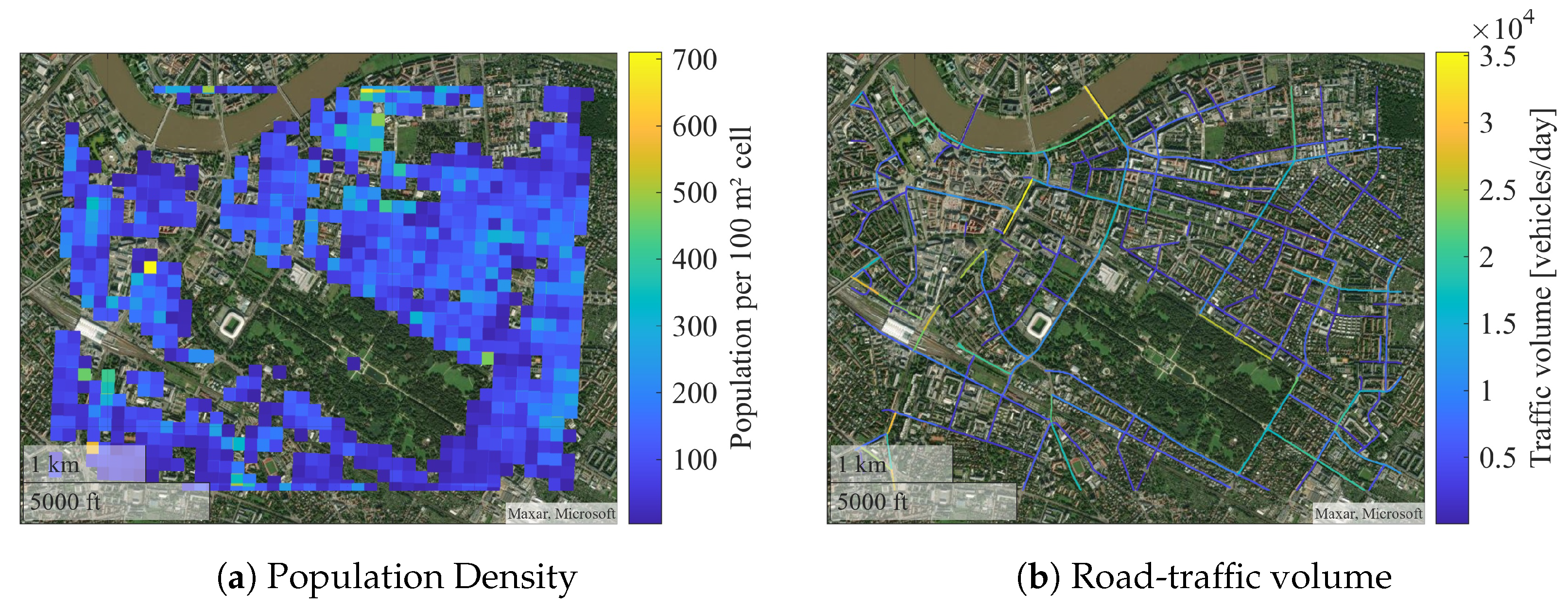Risk-Aware UAV Trajectory Optimization Using Open Urban GIS Data and Target Level of Safety Constraints
Abstract
1. Introduction
2. State of the Art
2.1. Regulatory Background in Aviation
2.2. Quantification of Ground Risk
2.3. Sheltering Effects
2.4. Risk-Based Optimal Pathfinding
3. Observed Limitations and Contributions
- We treat a predefined TLS as a hard constraint on accumulated, directional ground risk and jointly consider endurance, yielding mission-specific, TLS-compliant trajectories.
- We construct per-cell, directional risk maps from open urban GIS, accounting for ballistic descent, wind drift, and sheltering, and model spatiotemporal exposure that distinguishes pedestrians from vehicle occupants.
- We employ an A* search with adaptive weighting that balances flight time and risk, including distance normalization via a detour factor and dynamic weight adaptation.
- We validate on synthetic and real urban maps, reporting TLS compliance and detour factors to quantify the efficiency–safety trade-off.
4. Risk Assessment Methodology
4.1. Structure and Workflow
- Severity assessment: The potential outcome of an uncontrolled descent is quantified based on UAV parameters, flight altitude, and local conditions at the impact site. These include the sheltering effect of surrounding structures or vegetation, as well as the characteristics of the impacted target. For pedestrians, severity varies with the body region struck [11]; for vehicles, it depends on impact location (e.g., windshield, roof, engine bay) and vehicle speed.
- Likelihood assessment: The conditional probability of an impact is given by the joint occurrence of (i) a person or vehicle being present in the potential impact area, and (ii) an uncontrolled descent, based on the cumulative failure probability of all relevant safety events (platform-specific) and the dwell time above the cell. The likely drift path of the falling UAV–determined by ballistic descent dynamics and wind direction–is taken into account, resulting in anisotropic likelihood values.
- Risk estimation: The ground risk is computed as the product of severity and likelihood, yielding the directional fatality risk value assigned to the corresponding edge of the motion graph.
4.2. UAV Impact Energy
4.3. Modeling of Pedestrian Fatality Risk
4.4. Modeling of Street Fatality Risk
4.4.1. Leading Hazard Zone
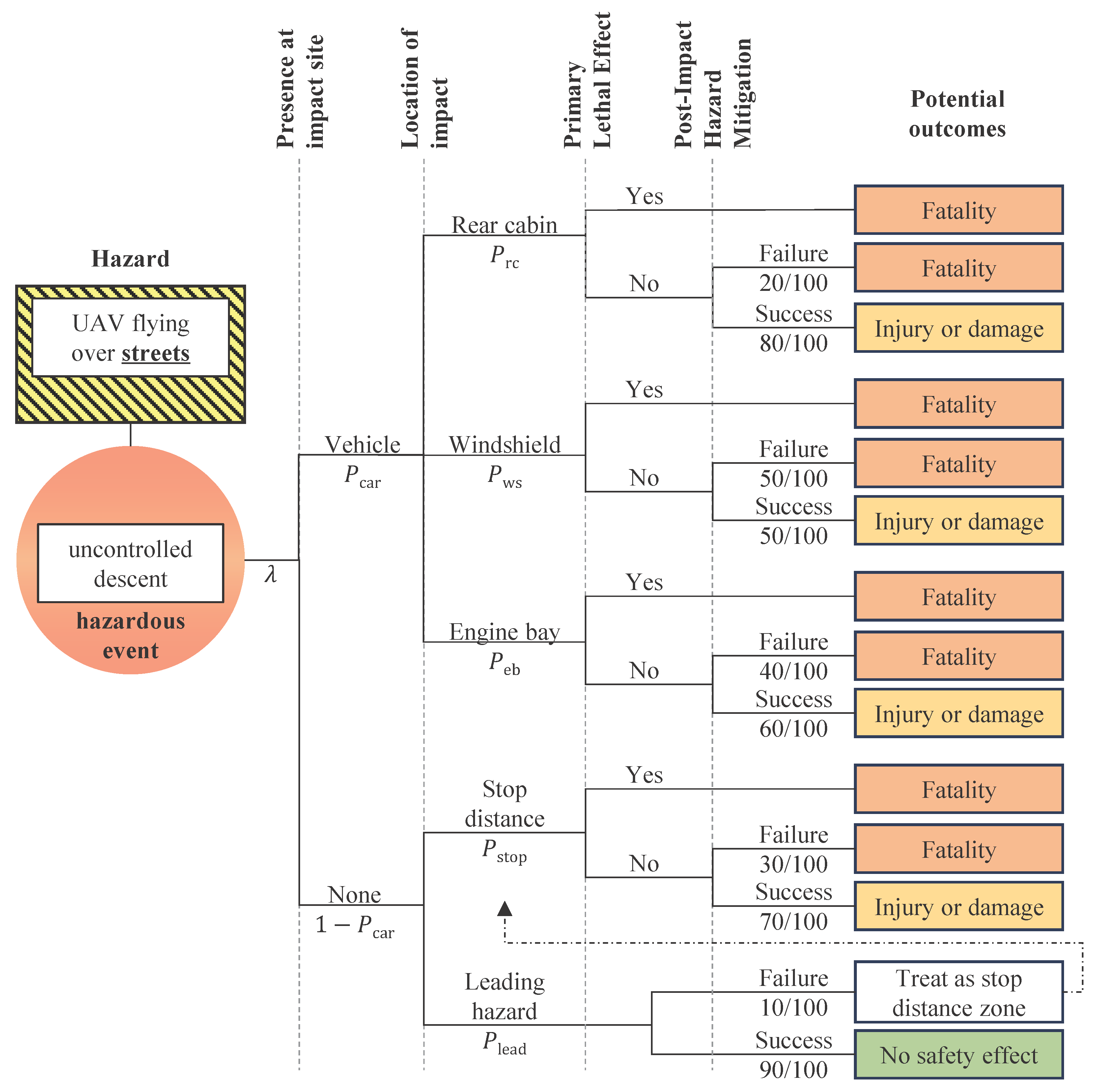
4.4.2. Stop Distance Zone
4.4.3. Engine Bay Zone
4.4.4. Windshield Zone
4.4.5. Rear Cabin Zone
4.4.6. Aggregate Fatality Risk
4.5. Contingency Volume Representation
4.6. Directional Risk Map
5. Risk-Constrained UAV Pathfinding
- is the accumulated path length from S to n,
- is the Euclidean distance from n to G,
- is the accumulated directional fatality risk from S to n,
- is the heuristic estimate of the remaining risk to G,
- is the accepted detour factor relative to the straight-line distance,
- is the target level of safety.
- is the UAV-specific failure rate per unit time leading to an uncontrolled descent,
- is the flight- or dwell time on edge from a to b,
- is the directional fatality risk for edge defined in Equation (45).
- is the UAV’s cruise speed,
- is the mean directional fatality risk along the direct line from n to G after Gaussian convolution.
6. Simulation Setup and Data Sources
6.1. Parameters of the Unmanned Aerial Vehicle
6.2. Simulation Setup for Synthetic Data
6.3. Case Study with Real GIS Data
- Road network for traffic-related fatality risk estimation (Section 4.4), including maximum permitted speed (interpolated where missing), road width, and number of lanes, all derived from OSM attributes.
- Pedestrian areas, working places, and living places to model the spatial distribution of persons. The pedestrian layer integrates area, line, and point features from OSM relevant to pedestrian presence. Area features (e.g., designated pedestrian zones) are rasterized directly. Linear features such as sidewalks, walking paths, and traffic-calmed streets are buffered prior to rasterization to approximate typical widths, as these are not consistently available in OSM. Generalized buffer radii are applied by infrastructure type (e.g., for sidewalks and pedestrian zones, for bicycle lanes). Point features such as public transport stops are similarly inflated to capture the surrounding zone of pedestrian activity. Buffer parameters can be adapted to local contexts or refined datasets if available.
- Sheltering features (buildings and vegetation) for risk reduction (Section 2.3). Building and forest polygons are rasterized directly, while point features representing individual trees are buffered using a generalized radius of .
7. Results
7.1. Synthetic Data Results
- Homogeneous high-risk clusters: Procedural generation occasionally produced large contiguous areas of elevated risk without intermediate safe cells, forcing extended detours.
- Extreme parameter combinations: Randomized city tiles sometimes combined high road-traffic density, high population density, and low building coverage—conditions unlikely to co-occur in real-world cities.
- Uniform street geometry: Orthogonal grid layouts reduce the availability of short alternative routes compared to the irregular street patterns of real cities.
- Strict grid movement: Even with 8-connectivity, blocked diagonals force stepwise zig-zag detours, amplifying path length.
- Low permeability of risk areas: Streets and sidewalks were modeled as sharply bounded high-risk features, eliminating partial traversal options that may exist in reality.
7.2. Real GIS Data Results
8. Conclusions and Outlook
Author Contributions
Funding
Data Availability Statement
Conflicts of Interest
Appendix A
| Input Type | Source | Access/Tagging Criteria | Description/Use |
|---|---|---|---|
| Basemap Imagery | Federal Agency for Cartography and Geodesy | Web Map Service [64] | Visual reference for terrain and infrastructure |
| Road Network | OSM (via Overpass API) | key = highway AND value ∈ {motorway, trunk, primary, secondary, tertiary, unclassified, residential, motorway_link, trunk_link, primary_link, secondary_link, tertiary_link} | Road hierarchy (e.g., motorway, residential), maximum permissible speed, number of lanes, road width |
| Pedestrian Areas | OSM (via Overpass API) | (key = highway AND value∈ {living_street, pedestrian, footway}) OR key ∈ {amenity, leisure, public_transport, shop, cycleway, sidewalk, sport, tourism} | Outdoor locations with expected pedestrian presence during public or transit activities (e.g., sidewalks, squares, leisure and retail areas) |
| Sheltering Features | OSM (via Overpass API) | key = building OR (key = landuse AND value = forest) OR (key = natural AND value ∈ {tree, wood, tree_row}) | Structures mitigating impact energy (e.g., buildings, vegetation) |
| Working Places | OSM (via Overpass API) | key = building AND value ∈ {commercial, office, industrial, college, goverment, hospital, kindergarten, museum, public, school, university} | Buildings with elevated daytime population (e.g., schools, hospitals, offices) |
| Population Density | Zensus 2022, Federal Statistical Office of Germany | 2022 Zensus—Populations in grid cells (Version 2: 30 September 2024) [60]. | Population counts per 100 raster cell (2022 census) |
| Ground Traffic Data | City of Dresden—Office for Geodata and Cadastre | Web Feature Service [61] | Traffic volumes per road segment in vehicles/day |
| Elevation/Terrain | GeoSN—Saxony State Office for Geoinformation and Surveying | GeoTIFF download [59] | Surface height incl. vegetation/buildings (DOM1) and bare-earth elevation (DGM1) |
| Spatiotemporal Population Data | Federal Ministry of Transport and Digital Infrastructure | Statistical distribution based on national MiD 2017 travel survey [62] | Hourly population shares at home, work, or in public (MiD 2017) |
References
- European Commision. Commission Implementing Regulation (EU) 2019/947 of 24 May 2019 on the Rules and Procedures for the Operation of Unmanned Aircraft (Text with EEA Relevance). Official Journal of the European Union, L 152, 11 June 2019, pp. 45–71, 2019. Available online: https://eur-lex.europa.eu/eli/reg_impl/2019/947/oj/eng (accessed on 18 September 2025).
- JARUS. JARUS Guidelines on Specific Operations Risk Assessment (SORA); Technical Report; Joint Authorities for Rulemaking on Unmanned Systems (JARUS): Edition 2.0, 2019. Available online: http://jarus-rpas.org/wp-content/uploads/2023/07/jar_doc_06_jarus_sora_v2.0.pdf (accessed on 18 September 2025).
- International Civil Aviation Organization. Safety Management Manual, 4th ed.; Number 9859 in ICAO Doc; International Civil Aviation Organization: Montréal, QC, Canada, 2018. [Google Scholar]
- Braßel, H.; Zeh, T.; Fricke, H.; Eltner, A. Optimal UAV Hangar Locations for Emergency Services Considering Restricted Areas. Drones 2023, 7, 203. [Google Scholar] [CrossRef]
- European Union Aviation Safety Agency. Acceptable Means of Compliance (AMC) and Guidance Material (GM) to Commission Implementing Regulation (EU) 2019/947; Annex to ED Decision 2023/012/R, ed. 1, amend. 3; European Union Aviation Safety Agency: Cologne, Germany, 2023. [Google Scholar]
- JARUS. JARUS Guidelines on Specific Operations Risk Assessment (SORA); Technical Report; Joint Authorities for Rulemaking on Unmanned Systems (JARUS): Edition 2.5, 2024. Available online: http://jarus-rpas.org/wp-content/uploads/2024/06/SORA-v2.5-Main-Body-Release-JAR_doc_25.pdf (accessed on 18 September 2025).
- International Civil Aviation Organization. Advanced Surface Movement Guidance and Control Systems: (A-SMGCS) Manual, 1st ed.; ICAO: Montreal, QC, Canada, 2004. [Google Scholar]
- Lin, X.; Fulton, N.; Westcott, M. Target Level of Safety Measures in Air Transportation—Review, Validation and Recommendations. In Proceedings of the IASTED International Conference Modelling, Simulation, and Identification (MSI2009), Beijing, China, 12–14 October 2009. [Google Scholar]
- Dalamagkidis, K.; Valavanis, K.P.; Piegl, L.A. (Eds.) On Integrating Unmanned Aircraft Systems into the National Airspace System; Springer: Dordrecht, The Netherlands, 2012; Volume 54. [Google Scholar] [CrossRef]
- Arterburn, D.; Ewing, M.; Prabhu, R.; Zhu, F.; Francis, D. FAA UAS Center of Excellence Task A4: UAS Ground Collision Severity Evaluation; Technical Report; Federal Aviation Administration: Washington, DC, USA, 2017.
- Range Safety Group. Common Risk Criteria for National Test Ranges: Inert Debris; Technical Report ADA388624; Range Commanders Council: White Sands Missle Range, NM, USA, 2000. [Google Scholar]
- Dalamagkidis, K.; Valavanis, K.P.; Piegl, L.A. On Unmanned Aircraft Systems Issues, Challenges and Operational Restrictions Preventing Integration into the National Airspace System. Prog. Aerosp. Sci. 2008, 44, 503–519. [Google Scholar] [CrossRef]
- Bir, C.; Viano, D.C. Design and Injury Assessment Criteria for Blunt Ballistic Impacts. J. Trauma Acute Care Surg. 2004, 57, 1218–1224. [Google Scholar] [CrossRef]
- Svatý, Z.; Vrtal, P.; Mičunek, T.; Kohout, T.; Nouzovský, L.; Frydrýn, M.; Blodek, T.; Kocián, K. Impact analysis assessment of UAS collision with a human body. PLoS ONE 2025, 20, e0320073. [Google Scholar] [CrossRef]
- Shelley, A.V. A model of human harm from a falling unmanned aircraft: Implications for UAS regulation. Int. J. Aviat. Aeronaut. Aerosp. 2016, 3, 1. [Google Scholar] [CrossRef]
- Clothier, R.; Walker, R.; Fulton, N.; Campbell, D. A casualty risk analysis for unmanned aerial system (UAS) operations over inhabited areas. In Proceedings of the AIAC12: 2nd Australasian Unmanned Air Vehicles Conference, Bristol UAV Conference, Melbourne, Australia, 19–22 March 2007; pp. 1–16. [Google Scholar]
- Aalmoes, R.; Cheung, Y.; Sunil, E.; Hoekstra, J.; Bussink, F. A conceptual third party risk model for personal and unmanned aerial vehicles. In Proceedings of the 2015 International Conference on Unmanned Aircraft Systems (ICUAS), Denver, CO, USA, 9–12 June 2015; pp. 1301–1309. [Google Scholar]
- Clothier, R.A.; Williams, B.P.; Hayhurst, K.J. Modelling the risks remotely piloted aircraft pose to people on the ground. Saf. Sci. 2018, 101, 33–47. [Google Scholar] [CrossRef]
- Barr, L.C.; Newman, R.; Ancel, E.; Belcastro, C.M.; Foster, J.V.; Evans, J.; Klyde, D.H. Preliminary risk assessment for small unmanned aircraft systems. In Proceedings of the 17th AIAA Aviation Technology, Integration, and Operations Conference, Denver, CO, USA, 5–9 June 2017; p. 3272. [Google Scholar]
- Osborne, M.; Lantair, J.; Shafiq, Z.; Zhao, X.; Robu, V.; Flynn, D.; Perry, J. UAS Operators Safety and Reliability Survey: Emerging Technologies towards the Certification of Autonomous UAS. In Proceedings of the 2019 4th International Conference on System Reliability and Safety (ICSRS), Rome, Italy, 20–22 November 2019; pp. 203–212. [Google Scholar] [CrossRef]
- Pilko, A.; Sóbester, A.; Scanlan, J.P.; Ferraro, M. Spatiotemporal Ground Risk Mapping for Uncrewed Aircraft Systems Operations. J. Aerosp. Inf. Syst. 2023, 20, 126–139. [Google Scholar] [CrossRef]
- La Cour-Harbo, A. Quantifying Risk of Ground Impact Fatalities for Small Unmanned Aircraft. J. Intell. Robot. Syst. 2019, 93, 367–384. [Google Scholar] [CrossRef]
- Kim, S.H. Third-Party Risk Analysis of Small Unmanned Aircraft Systems Operations. J. Aerosp. Inf. Syst. 2020, 17, 24. [Google Scholar] [CrossRef]
- Primatesta, S.; Rizzo, A.; La Cour-Harbo, A. Ground Risk Map for Unmanned Aircraft in Urban Environments. J. Intell. Robot. Syst. 2020, 97, 489–509. [Google Scholar] [CrossRef]
- La Cour-Harbo, A. Ground impact probability distribution for small unmanned aircraft in ballistic descent. In Proceedings of the 2020 International Conference on Unmanned Aircraft Systems (ICUAS), Athens, Greece, 1–4 September 2020; pp. 1442–1451. [Google Scholar] [CrossRef]
- Hammer, T.; Quitter, J.; Mayntz, J.; Bauschat, J.M.; Dahmann, P.; Götten, F.; Hille, S.; Stumpf, E. Free fall drag estimation of small-scale multirotor unmanned aircraft systems using computational fluid dynamics and wind tunnel experiments. CEAS Aeronaut. J. 2024, 15, 269–282. [Google Scholar] [CrossRef]
- Che Man, M.H.; Haoliang, H.; Low, K.H. Crash Area Estimation for Ground Risk of Small Unmanned Aerial Vehicles Due to Propulsion System Failures. In Proceedings of the AIAA SCITECH 2022 Forum, San Diego, CA, USA, 3–7 January 2022. [Google Scholar] [CrossRef]
- Bertrand, S.; Raballand, N.; Viguier, F. Evaluating Ground Risk for Road Networks Induced by UAV Operations. In Proceedings of the 2018 International Conference on Unmanned Aircraft Systems, Dallas, TX, USA, 12–15 June 2018; pp. 168–176. [Google Scholar] [CrossRef]
- Huo, J.; Fu, X.; Liu, Z.; Zhang, Q. Short-term estimation and prediction of pedestrian density in urban hot spots based on mobile phone data. IEEE Trans. Intell. Transp. Syst. 2021, 23, 10827–10838. [Google Scholar] [CrossRef]
- Jiang, R.; Cai, Z.; Wang, Z.; Yang, C.; Fan, Z.; Chen, Q.; Tsubouchi, K.; Song, X.; Shibasaki, R. DeepCrowd: A deep model for large-scale citywide crowd density and flow prediction. IEEE Trans. Knowl. Data Eng. 2021, 35, 276–290. [Google Scholar] [CrossRef]
- Kim, Y.; Bae, J. Risk-Based UAV Corridor Capacity Analysis above a Populated Area. Drones 2022, 6, 221. [Google Scholar] [CrossRef]
- Haklay, M.; Weber, P. Openstreetmap: User-generated street maps. IEEE Pervasive Comput. 2008, 7, 12–18. [Google Scholar] [CrossRef]
- Zhou, S.; Liu, Y.; Zhang, X.; Dong, H.; Zhang, W.; Wu, H.; Li, H. Risk Assessment and Distribution Estimation for UAV Operations with Accurate Ground Feature Extraction Based on a Multi-Layer Method in Urban Areas. Drones 2024, 8, 399. [Google Scholar] [CrossRef]
- Zhang, X.; Hao, H.; Ma, G. Laboratory test and numerical simulation of laminated glass window vulnerability to debris impact. Int. J. Impact Eng. 2013, 55, 49–62. [Google Scholar] [CrossRef]
- Hardwick, M.J.; Hall, J.; Tatom, J.W.; Baker, R.G. Approved Methods and Algorithms for DoD Risk-Based Explosives Siting; Technical Report TR 14; U.S. Department of Defense Explosives Safety Board: Alexandria, VA, USA, 2009. [Google Scholar]
- Che Man, M.H.; Haoliang, H.; Sivakumar, A.K.; Low, K.H. Preliminary Damage Severity Evaluation of Ground Vehicles and Covered Walkways under Collision with a Small Unmanned Aerial Vehicle (sUAV). In Proceedings of the AIAA AVIATION 2022 Forum, Chicago, IL, USA, 27 June–1 July 2022; American Institute of Aeronautics and Astronautics: Reston, VA, USA, 2022. [Google Scholar] [CrossRef]
- Pang, B.; Hu, X.; Dai, W.; Low, K.H. UAV path optimization with an integrated cost assessment model considering third-party risks in metropolitan environments. Reliab. Eng. Syst. Saf. 2022, 222, 108399. [Google Scholar] [CrossRef]
- Liu, B.; Xu, T.; Xu, X.; Wang, Y.; Sun, Y.; Li, Y. Energy absorption mechanism of polyvinyl butyral laminated windshield subjected to head impact: Experiment and numerical simulations. Int. J. Impact Eng. 2016, 90, 26–36. [Google Scholar] [CrossRef]
- Xu, J.; Li, Y.B. Study of damage in windshield glazing subject to impact by a pedestrian’s head. Proc. Inst. Mech. Eng. Part D J. Automob. Eng. 2009, 223, 77–84. [Google Scholar] [CrossRef]
- Aslan, M.F.; Durdu, A.; Sabanci, K. Goal distance-based UAV path planning approach, path optimization and learning-based path estimation: GDRRT*, PSO-GDRRT* and BiLSTM-PSO-GDRRT*. Appl. Soft Comput. 2023, 137, 110156. [Google Scholar] [CrossRef]
- Sun, X.; Zhang, B.; Chai, R.; Tsourdos, A.; Chai, S. UAV trajectory optimization using chance-constrained second-order cone programming. Aerosp. Sci. Technol. 2022, 121, 107283. [Google Scholar] [CrossRef]
- Rahman, M.M.H.; Al-Naeem, M.; Banerjee, A.; Sufian, A. EETO-GA: Energy Efficient Trajectory Optimization of UAV-IoT Collaborative System Using Genetic Algorithm. Appl. Sci. 2023, 13, 2535. [Google Scholar] [CrossRef]
- Debnath, D.; Hawary, A.F.; Ramdan, M.I.; Alvarez, F.V.; Gonzalez, F. QuickNav: An Effective Collision Avoidance and Path-Planning Algorithm for UAS. Drones 2023, 7, 678. [Google Scholar] [CrossRef]
- Hart, P.E.; Nilsson, N.J.; Raphael, B. A formal basis for the heuristic determination of minimum cost paths. IEEE Trans. Syst. Sci. Cybern. 1968, 4, 100–107. [Google Scholar] [CrossRef]
- Lin, J.; Ye, F.; Yu, Q.; Xing, J.; Quan, Z.; Sheng, C. Research on Multi-UAVs Route Planning Based on the Integration of Improved Elastic Band and A-Star Algorithm. In Proceedings of the 2022 IEEE International Conference on Unmanned Systems (ICUS), Guangzhou, China, 28–30 October 2022. [Google Scholar] [CrossRef]
- Du, Y. Multi-UAV search and rescue with enhanced A* algorithm path planning in 3D environment. Int. J. Aerosp. Eng. 2023, 2023, 8614117. [Google Scholar] [CrossRef]
- Xu, L.; Xi, M.; Gao, R.; Ye, Z.; He, Z. Dynamic path planning of UAV with least inflection point based on adaptive neighborhood A* algorithm and multi-strategy fusion. Sci. Rep. 2025, 15, 8563. [Google Scholar] [CrossRef]
- Zhang, X.; Liu, Y.; Gao, Z.; Ren, J.; Zhou, S.; Yang, B. A Ground-Risk-Map-Based Path-Planning Algorithm for UAVs in an Urban Environment with Beetle Swarm Optimization. Appl. Sci. 2023, 13, 11305. [Google Scholar] [CrossRef]
- Tang, H.; Zhu, Q.; Qin, B.; Song, R.; Li, Z. UAV path planning based on third-party risk modeling. Sci. Rep. 2023, 13, 22259. [Google Scholar] [CrossRef]
- Levasseur, B.; Bertrand, S.; Raballand, N.; Viguier, F.; Goussu, G. Accurate ground impact footprints and probabilistic maps for risk analysis of UAV missions. In Proceedings of the 2019 IEEE Aerospace Conference, Big Sky, MT, USA, 2–9 March 2019; pp. 1–10. [Google Scholar]
- Lin, C.E.; Shao, P.C. Failure Analysis for an Unmanned Aerial Vehicle Using Safe Path Planning. J. Aerosp. Inf. Syst. 2020, 17, 358–369. [Google Scholar] [CrossRef]
- Primatesta, S.; Scanavino, M.; Guglieri, G.; Rizzo, A. A Risk-based Path Planning Strategy to Compute Optimum Risk Path for Unmanned Aircraft Systems over Populated Areas. In Proceedings of the 2020 International Conference on Unmanned Aircraft Systems (ICUAS), Athens, Greece, 1–4 September 2020; pp. 641–650. [Google Scholar] [CrossRef]
- Pilko, A.; Oakey, A.; Ferraro, M.; Scanlan, J. The Price of a Safe Flight: Risk Cost Based Path Planning. In Proceedings of the 2024 IEEE International Conference on Robotics and Automation (ICRA), Yokohama, Japan, 13–17 May 2024; pp. 3884–3890. [Google Scholar] [CrossRef]
- Gao, Z.; Clarke, J.P.; Mardanov, J.; Marais, K. Developing 3D risk-informed no-fly zones for urban UAS operations. Aerosp. Sci. Technol. 2025, 163, 110297. [Google Scholar] [CrossRef]
- International Civil Aviation Organization. Procedures for Air Navigation Services—Aircraft Operations, Volume I: Flight Procedures, 6th ed.; International Civil Aviation Organization (ICAO): Montréal, QC, Canada, 2018; ICAO Doc 8168; Volume I. [Google Scholar]
- Runge, C. Ueber die numerische Auflösung von Differentialgleichungen. Math. Ann. 1895, 46, 167–178. [Google Scholar] [CrossRef]
- Bresenham, J.E. Algorithm for computer control of a digital plotter. IBM Syst. J. 1965, 4, 25–30. [Google Scholar] [CrossRef]
- European Commission. Commission Delegated Regulation (EU) 2019/945 of 12 March 2019 on Unmanned Aircraft Systems and on Third-Country Operators of Unmanned Aircraft Systems. Official Journal of the European Union, L 152, 11 June 2019, pp. 1–40, 2019. Available online: http://data.europa.eu/eli/reg_del/2019/945/oj (accessed on 18 September 2025).
- GeoSN—Saxony State Office for Geoinformation and Surveying. Digital Surface Model (DOM1) and Digital Terrain Model (DGM1), 2024. Available under the Data License Germany—Attribution—Version 2.0 (dl-de/by-2-0). Source: GeoSN, dl-de/by-2-0. Available online: https://www.geodaten.sachsen.de/digitale-hoehenmodelle-3994.html (accessed on 16 July 2025).
- Statistische Ämter des Bundes und der Länder. Zensus 2022—Bevölkerungszahlen in Gitterzellen, 2nd ed.; Federal Statistical Office of Germany: Wiesbaden, Germany, 2024. [Google Scholar]
- City of Dresden–Office for Geodata and Cadastre. Traffic Volume Data (Vehicles per Day) from the Thematic City Map. 2024. Available online: https://stadtplan.dresden.de (accessed on 10 July 2025).
- Nobis, C.; Kuhnimhof, T. Mobilität in Deutschland—MiD Ergebnisbericht. A Study by Infas, DLR, IVT and Infas 360 on Behalf of the Federal Ministry for Transport and Digital Infrastructure (FE-Nr. 70.904/15). Chapter 7, Figure 7: Weekly Patterns of Population Locations. Bonn, Germany, 2018. Available online: https://www.mobilitaet-in-deutschland.de (accessed on 5 June 2025).
- Statistische Ämter der Länder. Qualitätsbericht, Pendlerrechnung der Länder, Stand: 16.10.2024; Technical Report; Information und Technik Nordrhein-Westfalen (IT.NRW); Statistisches Landesamt, im Auftrag der Statistischen Ämter der Länder: Düsseldorf, Germany, 2024. [Google Scholar]
- Federal Agency for Cartography and Geodesy (BKG). basemap.de Web Raster (WMS Service). © GeoBasis-DE/BKG. 2024. Available online: https://www.bkg.bund.de (accessed on 21 July 2025).

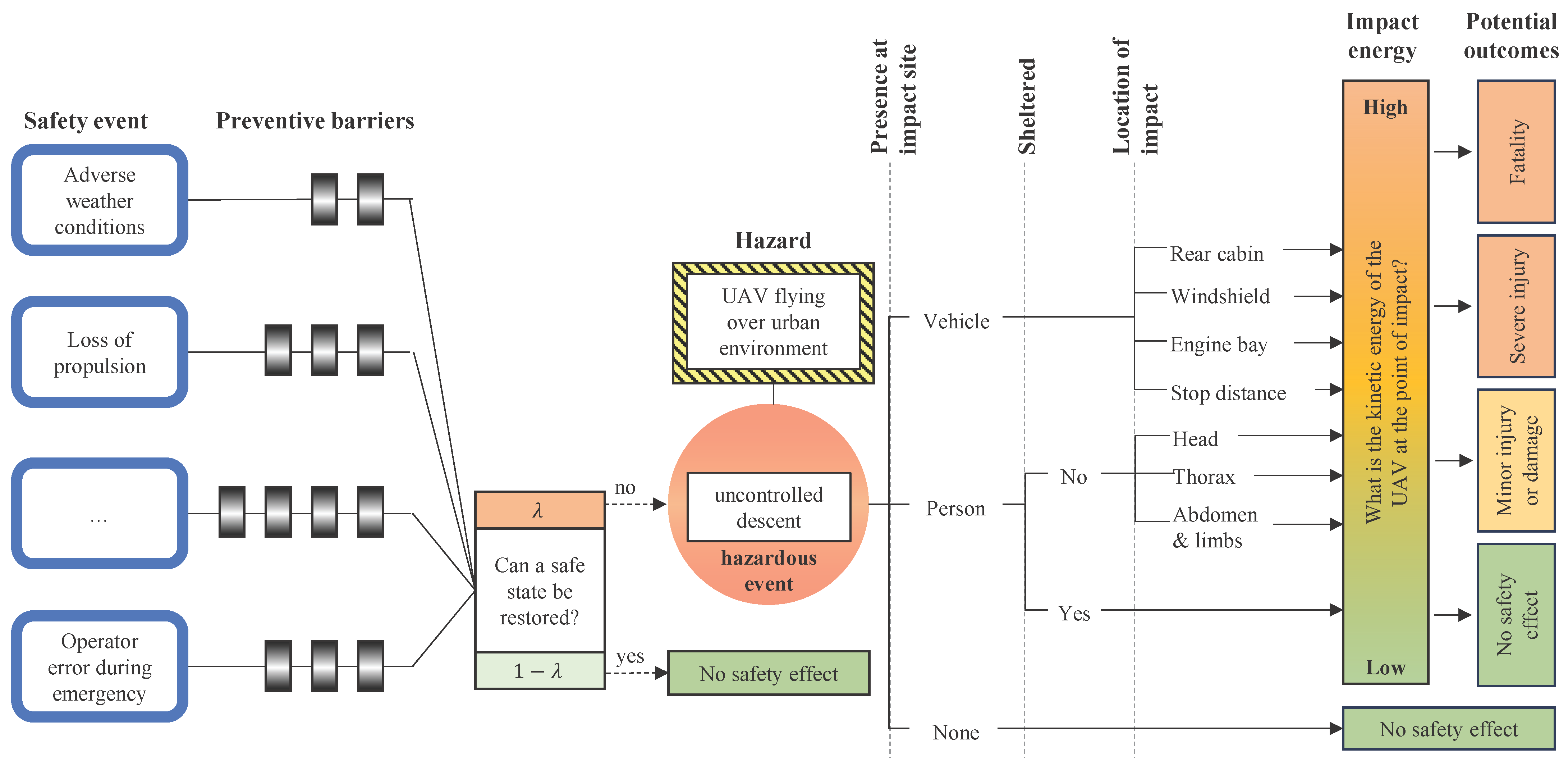
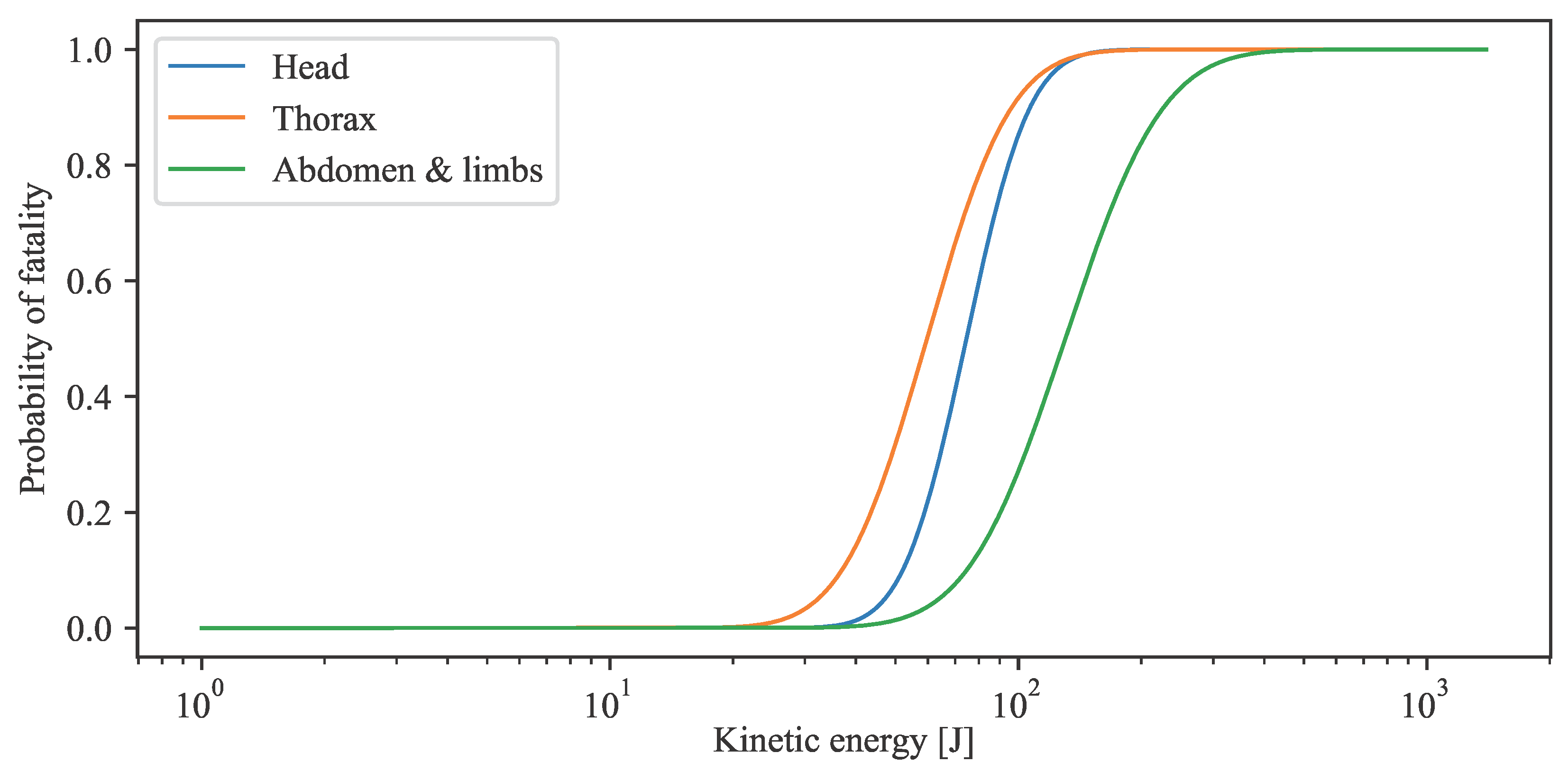
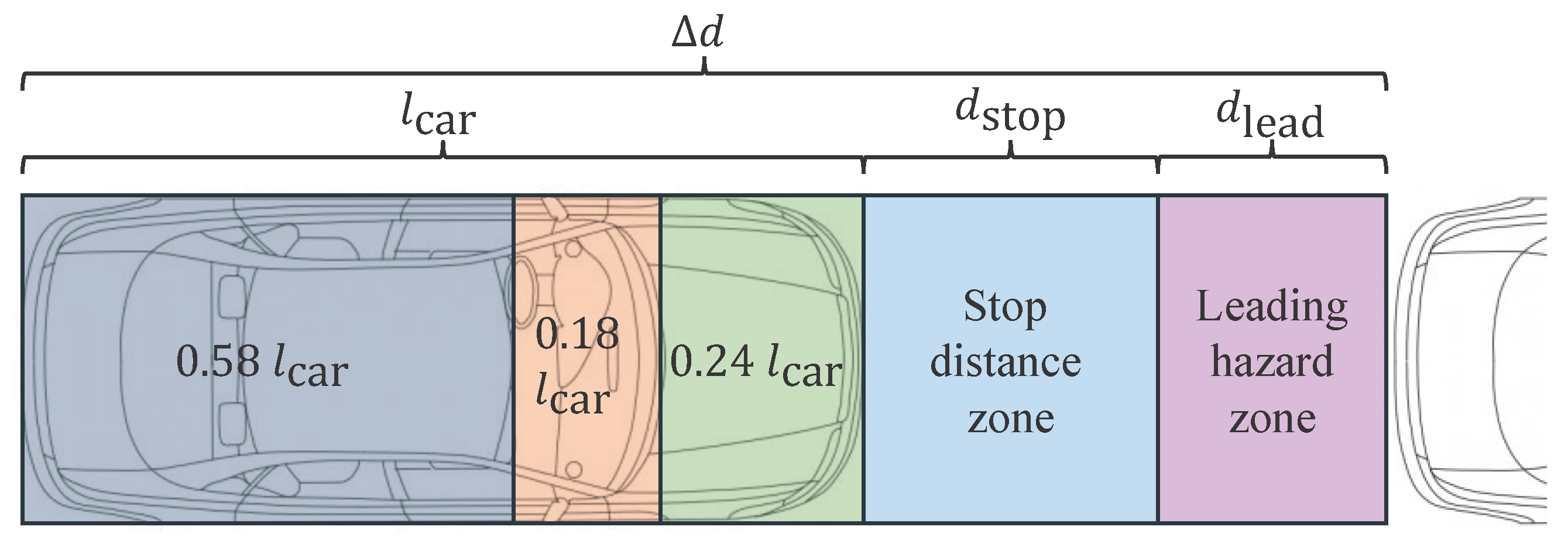
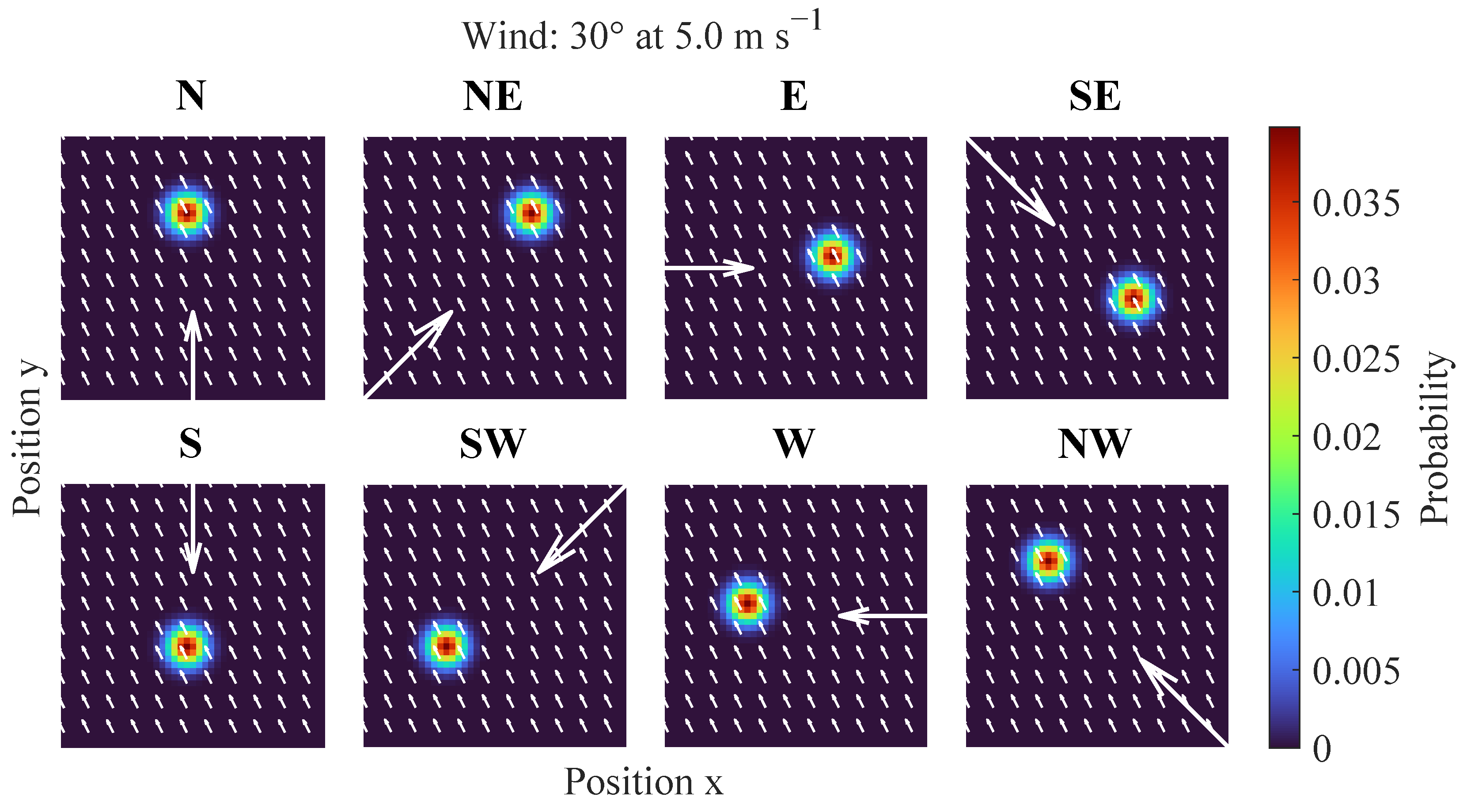


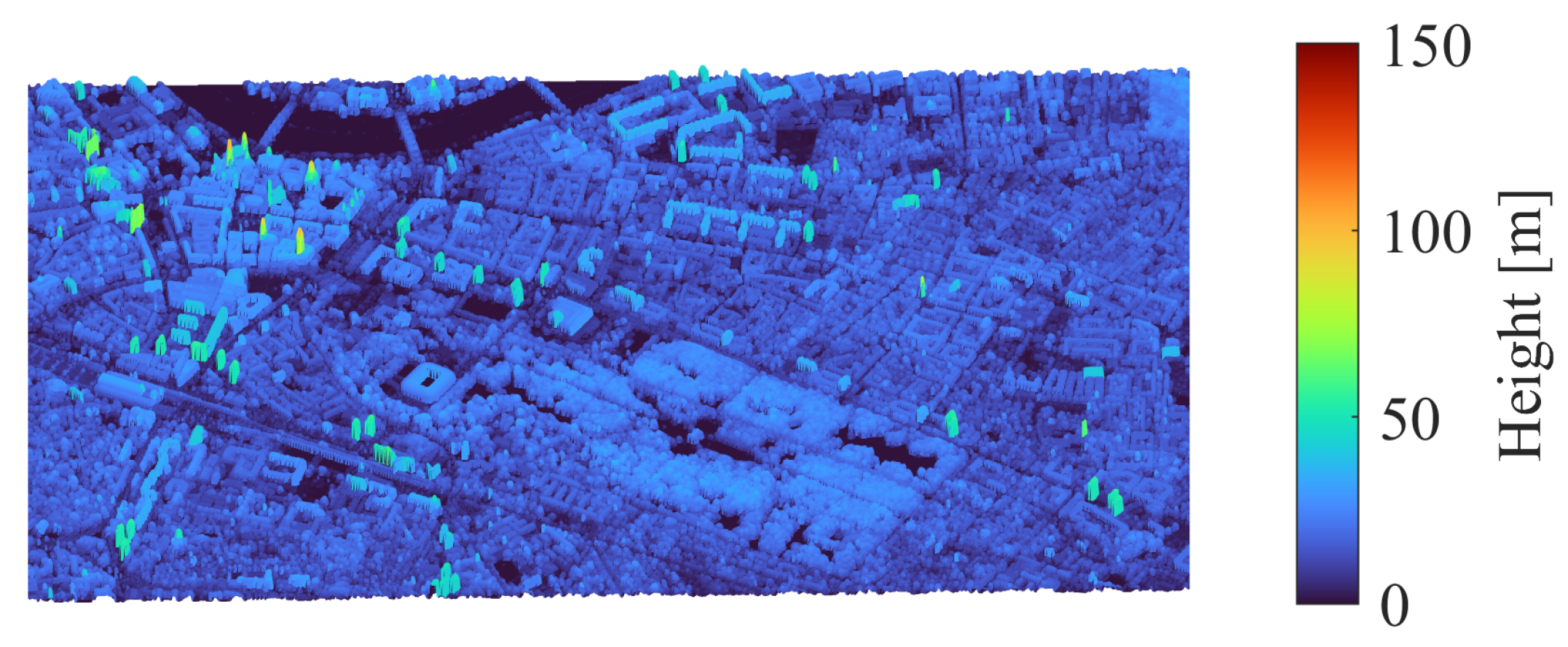





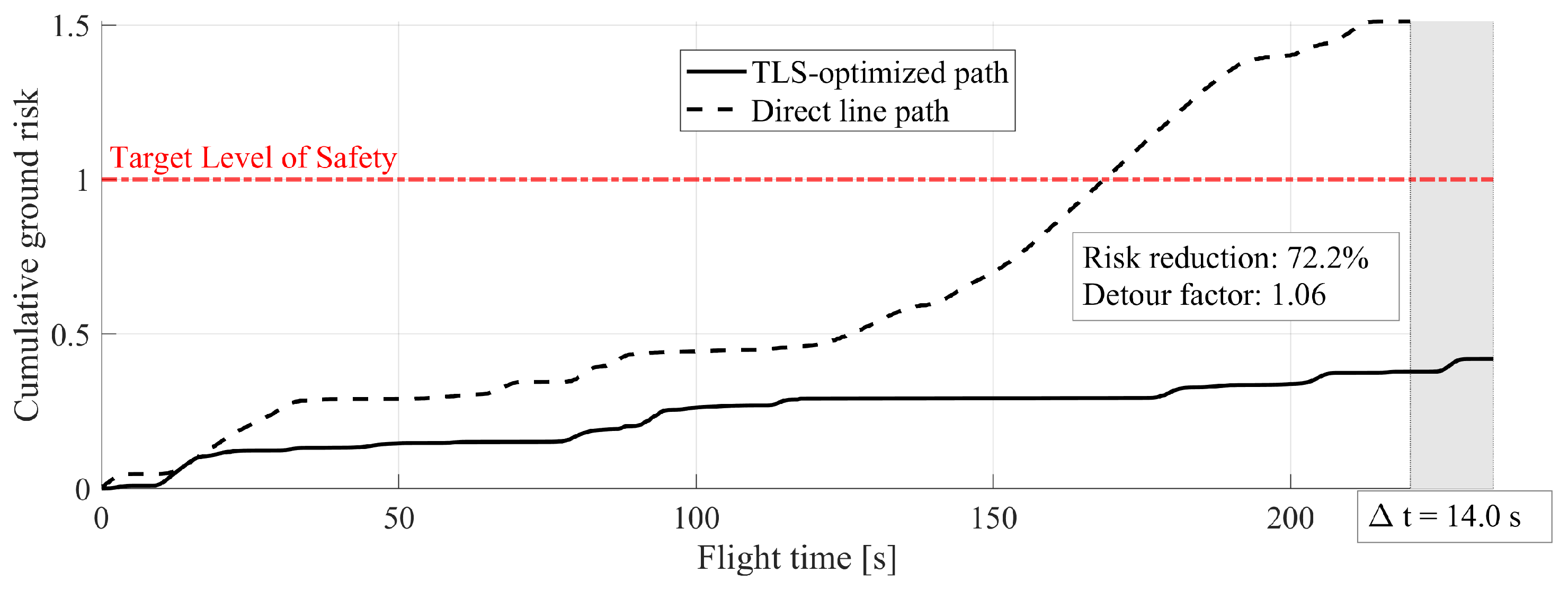
| Body Part | Area | Relative Area | Log-Normal Distribution | |
|---|---|---|---|---|
| [m2] | [%] | [J] | ||
| Head | 0.025 | 29.27 | 74.57 | 0.2802 |
| Thorax | 0.038 | 43.21 | 59.66 | 0.3737 |
| Abdomen, limbs | 0.0242 | 27.52 | 130.16 | 0.4335 |
| UAV Type | UAV Mass | UAV Surface Area | Drag Coefficient |
|---|---|---|---|
| (Class) | [kg] | [m2] | |
| UAV 1 (C1) | 0.75 | 0.0147 | 0.2670 |
| UAV 2 (C2) | 3.60 | 0.0667 | 0.1635 |
| UAV 3 (C3) | 11.00 | 0.2006 | 0.2225 |
| Type | Width | Spacing | Speed | Quantity | Road Traffic Load |
|---|---|---|---|---|---|
| [m] | [m] | [km h−1] | [d−1] | ||
| Main | 12 | 300 | 50 | 7 | [15,000, 50,000] |
| Side | 6 | 75 | 30 | 50 | [100, 10,000] |
| Type | Size | Height | Quantity | Energy Absorption |
|---|---|---|---|---|
| [m] | [m] | [J] | ||
| Building | 10, 100 | 20 | 400 | 13,558 |
| Tree | 3, 20 | 10 | 300 | 68 |
| UAV Class | Total Runs | Pass TLS Count | Pass TLS Rate |
|---|---|---|---|
| UAV 1 (C1) | 341 | 341 | 1.000 |
| UAV 2 (C2) | 334 | 319 | 0.955 |
| UAV 3 (C3) | 359 | 128 | 0.357 |
Disclaimer/Publisher’s Note: The statements, opinions and data contained in all publications are solely those of the individual author(s) and contributor(s) and not of MDPI and/or the editor(s). MDPI and/or the editor(s) disclaim responsibility for any injury to people or property resulting from any ideas, methods, instructions or products referred to in the content. |
© 2025 by the authors. Licensee MDPI, Basel, Switzerland. This article is an open access article distributed under the terms and conditions of the Creative Commons Attribution (CC BY) license (https://creativecommons.org/licenses/by/4.0/).
Share and Cite
Braßel, H.; Zeh, T.; Lindner, M.; Fricke, H. Risk-Aware UAV Trajectory Optimization Using Open Urban GIS Data and Target Level of Safety Constraints. Drones 2025, 9, 666. https://doi.org/10.3390/drones9100666
Braßel H, Zeh T, Lindner M, Fricke H. Risk-Aware UAV Trajectory Optimization Using Open Urban GIS Data and Target Level of Safety Constraints. Drones. 2025; 9(10):666. https://doi.org/10.3390/drones9100666
Chicago/Turabian StyleBraßel, Hannes, Thomas Zeh, Martin Lindner, and Hartmut Fricke. 2025. "Risk-Aware UAV Trajectory Optimization Using Open Urban GIS Data and Target Level of Safety Constraints" Drones 9, no. 10: 666. https://doi.org/10.3390/drones9100666
APA StyleBraßel, H., Zeh, T., Lindner, M., & Fricke, H. (2025). Risk-Aware UAV Trajectory Optimization Using Open Urban GIS Data and Target Level of Safety Constraints. Drones, 9(10), 666. https://doi.org/10.3390/drones9100666








